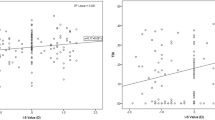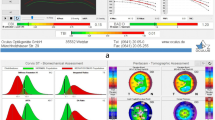Abstract
Purpose
To investigate whether cornea verticillata affects corneal topography, tomography, densitometry, or biomechanics of Fabry patients with ocular manifestations and to compare these results with those obtained from healthy subjects.
Methods
This prospective, cross-sectional study included 23 Fabry patients (Fabry group) with cornea verticillata and the 37 age- and sex-matched healthy subjects (control group). After comprehensive ophthalmological examinations, corneal topography, tomography, and densitometry measurements were taken using Pentacam HR and corneal biomechanics were captured via Corvis ST for all participants.
Results
All the investigated topographic and tomographic values were similar in the eyes with Fabry disease (FD) and the controls (P > 0.05). The corneal densitometry values of patients with FD were statistically significantly higher in all the concentric zones and layers, except posterior 0–2 mm and posterior 2–6 mm zones, compared to the controls (P < 0.05). The mean values of A1 velocity, A2 velocity, deformation amplitude ratio, Corvis biomechanical index, tomographic and biomechanical index, and Stiffness parameter at the first applanation in the Fabry group were statistically significantly different compared to control group (P < 0.05). However, the mean values of A1 length, A2 length, and the biomechanically corrected intraocular pressure were similar between the groups (P = 0.317, P = 0.819, and P = 0.468; respectively).
Conclusion
Although cornea verticillata associated with FD is not considered to affect vision, it is associated with increased light backscattering and reduced corneal transparency as well as altered corneal biomechanical properties.

Similar content being viewed by others
References
Germain DP (2010) Fabry disease. Orphanet J Rare Dis 5:30
Poorthuis BJ, Wevers RA, Kleijer WJ, Groener JE, de Jong JG, van Weely S et al (1999) The frequency of lysosomal storage diseases in the Netherlands. Hum Genet 105:151–156
Spada M, Pagliardini S, Yasuda M, Tukel T, Thiagarajan G, Sakuraba H et al (2006) High incidence of later onset Fabry disease revealed by newborn screening. Am J Hum Genet 79:31–40
San Roman I, Rodriguez ME, Caporossi O, Zoppetti C, Sodi A, Mecocci A et al (2017) Computer assisted retinal vessel tortuosity evaluation in novel mutation Fabry disease: towards new prognostic markers. Retina 37:592–603
Sodi A, Ioannidis AS, Mehta A, Davey C, Beck M, Pitz S (2007) Ocular manifestations of Fabry’s disease: data from the Fabry Outcome Survey. Br J Ophthalmol 91:210–214
Sodi A (2010) The eye in Fabry disease. In: Elstein D, Altarescu G, Beck M (eds) Fabry disease. Springer, London, UK, pp 299–306
Samiy N (2008) Ocular features of Fabry disease: diagnosis of a treatable life-threatening disorder. Surv Ophthalmol 53:416–423
Nguyen TT, Gin T, Nicholls K, Low M, Galanos J, Crawford A (2005) Ophthalmological manifestations of Fabry disease: a survey of patients at the Royal Melbourne Fabry Disease Treatment Centre. Clin Exp Ophthalmol 33:164–168
Orssaud C, Dufier J, Germain D (2003) Ocular manifestations in Fabry disease: a survey of 32 hemizygous male patients. Ophthalmic Genet 24:129–139
Lopes B, Ramos I, Ambrósio R (2014) Corneal densitometry in keratoconus. Cornea 33:1282–1286
Salomão MQ, Hofling-Lima AL, Faria-Correia F, Lopes BT, Rodrigues-Barros S, Roberts CJ et al (2018) Dynamic corneal deformation response and integrated corneal tomography. Indian J Ophthalmol 66:373–382
Ambrósio R Jr, Lopes BT, Faria-Correia F, Salomão MQ, Bühren J, Roberts CJ et al (2017) Integration of Scheimpflug-based corneal tomography and biomechanical assessments for enhancing ectasia detection. J Refract Surg 33:434–443
Hong J, Xu J, Wei A, Deng SX, Cui X, Yu X et al (2013) A new tonometer-- the Corvis ST tonometer: clinical comparison with noncontact and Goldmann applanation tonometers. Invest Ophthalmol Vis Sci 54:659–665
Bak-Nielsen S, Pedersen IB, Ivarsen A, Hjortdal J (2015) Repeatability, reproducibility, and age dependency of dynamic Scheimpflug-based pneumotonometer and its correlation with a dynamic bidirectional pneumotonometry device. Cornea 34:71–77
Davey PG (2014) Fabry disease: a survey of visual and ocular symptoms. Clin Ophthalmol 8:1555–1560
Sher NA, Letson RD, Desnick RJ (1979) The ocular manifestations in Fabry’s disease. Arch Ophthalmol 97:671–676
Zarate YA, Hopkin RJ (2008) Fabry’s disease. Lancet 372:1427–1435
Spaeth GL, Frost P (1965) Fabry’s disease. Its ocular manifestations. Arch Ophthalmol 74:760–769
Sivley MD (2013) Fabry disease: a review of ophthalmic and systemic manifestations. Optom Vis Sci 90:63–78
Raizman MB, Hamrah P, Holland EJ, Kim T, Mah FS, Rapuano CJ et al (2017) Drug-induced corneal epithelial changes. Surv Ophthalmol 62:286–301
van der Tol L, Sminia ML, Hollak CE, Biegstraaten M (2016) Cornea verticillata supports a diagnosis of Fabry disease in non-classical phenotypes: results from the Dutch cohort and a systematic review. Br J Ophthalmol 100:3–8
Koh S, Haruna M, Asonuma S, Maeda N, Hamano T, Sakai N et al (2019) Quantitative evaluation of visual function in patients with cornea verticillata associated with Fabry disease. Acta Ophthalmol doi. https://doi.org/10.1111/aos.14143[Epub ahead of print]
Otri AM, Fares U, Al-Aqaba MA, Dua HS (2012) Corneal densitometry as an indicator of corneal health. Ophthalmology 119:501–508
Sekeroglu MA, Anayol MA, Gulec M, Atalay M, Ozgul Yilmazoglu M, Yilmazbas P (2016) Corneal densitometry: a new technique for objective assessment of corneal clarity in Pseudoexfoliation syndrome. J Glaucoma 25:775–779
Oliveira CM1, Ribeiro C, Franco S (2011) Corneal imaging with slit-scanning and Scheimpflug imaging techniques. Clin Exp Optom 94:33–42
O’Donnell C, Wolffsohn JS (2004) Grading of corneal transparancy. Cont Lens Anterior Eye 27:161–170
Tekin K, Sekeroglu MA, Kiziltoprak H, Yilmazbas P (2017) Corneal densitometry in healthy corneas and its correlation with endothelial morphometry. Cornea 36:1336–1342
Özyol P, Özyol E (2018) Assessment of corneal backward light scattering in diabetic patients. Eye Contact Lens 44:92–96
Tekin K, Kiziltoprak H, Koc M, Goker YS, Kocer AM, Yilmazbas P (2019) The effect of corneal infiltrates on densitometry and higher-order aberrations. Clin Exp Optom 102:140–146
Enders P, Holtick U, Schaub F, Tuchscherer A, Hermann MM, Scheid C, et al (2017) Corneal densitometry for quantification of corneal deposits in monoclonal Gammopathies. 2017; 36: 470-475
Anayol MA, Sekeroglu MA, Ceran BB, Dogan M, Gunaydin S, Yilmazbas P (2016) Quantitative assessment of corneal clarity in keratoconus: a case control study of corneal densitometry. Eur J Ophthalmol 26:18–23
Dupps WJ Jr, Wilson SE (2006) Biomechanics and wound healing in the cornea. Exp Eye Res 83:709–720
Koc M, Aydemir E, Tekin K, Inanc M, Kosekahya P, Kiziltoprak H (2019) Biomechanical analysis of subclinical keratoconus with normal topographic, topometric, and tomographic findings. J Refract Surg 35:247–252
Mahendradas P, Francis M, Vala R, Gowda PB, Kawali A, Shetty R, et al (2018) Quantification of ocular biomechanics in ocular manifestations of systemic autoimmune diseases Ocul Immunol Inflamm doi: https://doi.org/10.1080/09273948.2018.1501491. [Epub ahead of print]
Ramm L, Herber R, Spoerl E, Pillunat LE, Terai N (2019) Measurement of corneal biomechanical properties in diabetes mellitus using the ocular response analyzer and the Corvis ST. Cornea 38:595–599
Scheibenberger D, Frings A, Steinberg J, Schüler H, Druchkiv V, Katz T et al (2018) Ocular manifestation in Marfan syndrome: corneal biomechanical properties relate to increased systemic score points. Graefes Arch Clin Exp Ophthalmol 256:1159–1163
Monnier VM, Sell DR, Abdul-Karim FW, Emancipator SN (1988) Collagen browning and cross-linking are increased in chronic experimental hyperglycemia. Relevance to diabetes and aging Diabetes 37:867–872
Perez-Rico C, Gutierrez-Ortiz C, Gonzales-Mesa A, Zandueta AM, Moreno-Salgueiro A, Germain F (2015) Effect of diabetes mellitus on Corvis ST measurement process. Acta Ophthalmol 93:193–198
Author information
Authors and Affiliations
Corresponding author
Ethics declarations
Conflict of interest
The authors declare that they have no conflict of interest.
Ethical approval
All procedures performed in studies involving human participants were in accordance with the ethical standards of the institutional and/or national research committee and with the 1964 Helsinki declaration and its later amendments or comparable ethical standards. For this type of study, formal consent is not required.
Informed consent
Informed consent was obtained from all individual participants included in the study.
Additional information
Publisher’s note
Springer Nature remains neutral with regard to jurisdictional claims in published maps and institutional affiliations.
Rights and permissions
About this article
Cite this article
Cankurtaran, V., Tekin, K., Cakmak, A.I. et al. Assessment of corneal topographic, tomographic, densitometric, and biomechanical properties of Fabry patients with ocular manifestations. Graefes Arch Clin Exp Ophthalmol 258, 1057–1064 (2020). https://doi.org/10.1007/s00417-019-04593-8
Received:
Revised:
Accepted:
Published:
Issue Date:
DOI: https://doi.org/10.1007/s00417-019-04593-8




